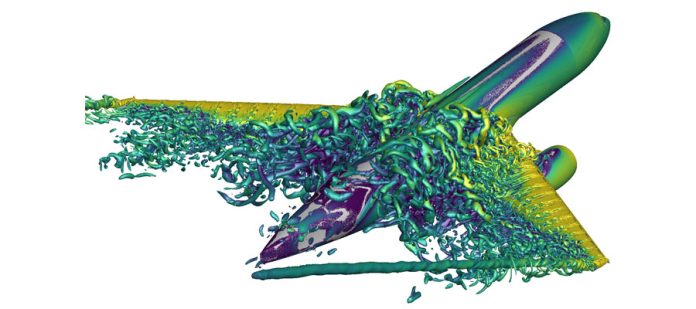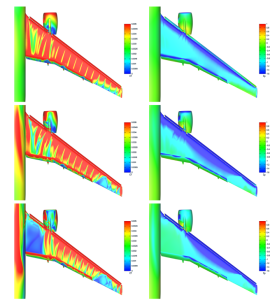Courtesy: Cadence Systems
Accurate lift prediction during takeoff and landing is crucial for the safe operation of commercial airplanes. This aspect significantly influences key parameters such as maximum takeoff weight and runway length. The aerodynamics of high-lift aircraft can be quite complex, involving various interacting features like wakes, vortices, and boundary layers.
Recent advancements in computational fluid dynamics (CFD), particularly large eddy simulation (LES), provide better insights into different designs and highly accurate CFD results. However, lower fidelity methods like Reynolds-Averaged Navier-Stokes (RANS) remain essential for fast assessments, optimization, and other critical tasks for aircraft design. Improvements in RANS turbulence modeling, specifically in the Cadence Fidelity Flow density-based solver (DBS), have enhanced the ability to manage complex flow fields with greater numerical stability and accuracy. Furthermore, multigrid and CPU booster technologies in Fidelity CFD have significantly improved convergence speed.
A noteworthy case study on the Common Research Model high lift (CRM-HL) configuration showcases how RANS turbulence modeling in Fidelity CFD supports simulating multiple aircraft designs with faster turnaround time, a vital factor in the highly competitive aviation industry and assists manufacturers in achieving certification.
CRM-HL Case Study: Modeling and Simulation
The full-scale normal landing configuration of the CRM-HL model is used in this case study, and it features specific flap deflections and a nacelle/pylon design with vortex-generating chine on the upper surface of the nacelle. Utilizing Cadence Fidelity Pointwise for mesh generation has proven advantageous, creating high-quality grids and ensuring a grid convergence level suitable for trend prediction and comparing different aircraft designs.
CRM-HL Configuration
Using anisotropic cells in key spots—like rounded leading edges, blunt trailing edges, and areas that create vortices—can reduce the number of cells. Lowering the count by as much as ten times! This gives a mesh with just 75 million cells, which is super helpful for spotting trends and comparing designs or optimizing.
Surface mesh on the wing and nacelle
Robust convergence was routinely achieved for all computations performed with the Fidelity Flow solver. The SA-QCR2000-RC turbulence model emerged as particularly effective, demonstrating optimal convergence speed in accordance with CFL (Courant-Friedrichs-Lewy) usage and the total iterations required per angle of attack. This model strikes an excellent balance between accuracy and computational efficiency, making it well-suited for similar high-lift studies.
The methodology accurately predicts critical aerodynamic characteristics like lift, drag, and pitching moments. A significant focus of the analysis has been on airflow behavior around the wing at various angles of attack. Initial tests concentrated on small angles before gradually progressing to higher levels. This testing phase aimed to understand the wing’s performance in terms of lift and drag during different flight conditions.
The friction and pressure coefficient contours on the aircraft surface at a), b) 7.05° angle of attack, c) d) 17.05° angle of attack, and e) f) 22.5° angle of attack
The predictive methods employed showed promising results, particularly at lower angles where the CFD predictions closely aligned with real-life data. However, as the angle of attack increased, some discrepancies arose, especially in near-stall conditions. Given the inherent uncertainties in experimental setups, these inconsistencies were considered acceptable.
Visualization tools were important in improving the understanding of how airflow varies with different angles of attack. Observations showed that at lower angles, airflow remains smooth over the wing. However, as the angle increases, some areas of the wing experience turbulence and airflow separation, which negatively impacts lift and increases drag. Overall, these analyses are essential for optimizing wing performance across various flying conditions.
Flow field comparison at AoA7.05° (Wind Tunnel data)
With continuing advancements in CFD technology and modeling techniques, the aviation industry is better equipped to ensure the safety and efficiency of high-lift aircraft, ultimately leading to improved designs and enhanced flight experience.
- High-Fidelity Aerodynamic Modeling: Discover how advanced CFD techniques are used to simulate complex high-lift aircraft flows with high accuracy.
- Turbulence Modeling Innovations: Understand the impact of advanced turbulence models on predicting aerodynamic forces and moments.
- Real-World Case Study: Explore simulations of the Common Research Model High Lift (CRM-HL) configuration validated against wind tunnel data, reducing reliance on costly physical testing.
- Optimized Meshing Techniques: Learn how advanced meshing practices improve computational efficiency while ensuring accurate trend predictions for aircraft designs.













